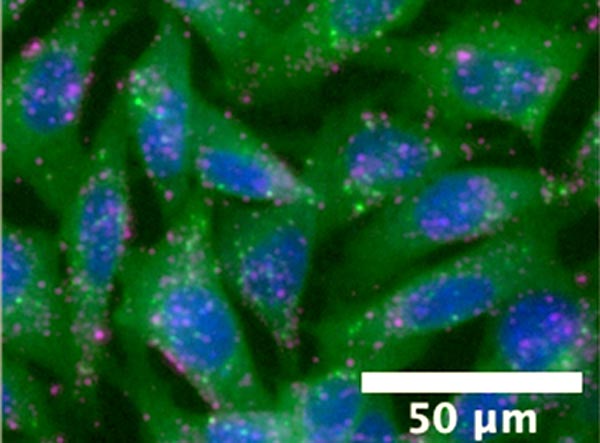New color-coded test quickly reveals if medical nanoparticles deliver their payload

Microscope image of the cells used to test nanoparticles. The cells here are genetically engineered to fluoresce at points where endosomes carrying nanoparticles into the cell are opened.
Credit: Jordan Green; Johns Hopkins Medicine
Johns Hopkins Medicine researchers have developed a color-coded test that quickly signals whether newly developed nanoparticles — ultra small compartments designed to ferry medicines, vaccines and other therapies — deliver their cargo into target cells. Historically, nanoparticles have a very low delivery rate to the cytosol, the inside compartment of cells, releasing only about 1%–2% of their contents.
The new testing tool, engineered specifically to test nanoparticles, could advance the search for next-generation biological medicines. The technology builds upon nanoparticles currently used against cancer and eye disease, and in vaccines for viruses including SARS-CoV-2, the virus that causes COVID-19.
The researchers report details of the tool, tested in mouse cells grown in the laboratory and in living mice, in the Jan. 5 issue of Science Advances.
“Many of the current assessment tools for nanoparticles only test whether a nanoparticle reaches a cell, not if the therapy can successfully escape the degradative environment of the endosome to reach inside the cytosol of the cell, which is where the medicine needs to be located for performance,” says Jordan Green, Ph.D., professor of biomedical engineering at the Johns Hopkins University School of Medicine. The new tool was created to track location and nanoparticle release, he said.
Previous research has estimated that only about 1%–2% of nanoparticles “eaten” by cells are able to escape the cellular compartments that trap them to avoid being digested or “spit back out.” In addition to the properties of its cargo, a nanoparticle’s chemical properties determine whether it is accepted by a cell and able to evade its cellular defenses.
To surmount such obstacles to final delivery, Green and his team designed a screening tool that assesses hundreds of nanoparticle formulations on their ability to not just reach a cell, but also how efficiently the nanoparticle can escape with its cargo to reach a cell’s interior.
The test uses mouse cells grown in the laboratory that are genetically engineered to carry a florescent marker called Gal8-mRuby, which shines orange-red when a cellular envelope that engulfs a nanoparticle opens, releasing its cargo into the cell.
Images of the process are then analyzed by a computer program that quickly tracks the nanoparticle location using red fluorescent light and quantifies how effective the nanoparticles are at being released into the cell by assessing the amount of orange-red fluorescent light. Using this technique, a laboratory can screen hundreds of unique nanoparticles for delivery in a few hours, with detailed information about the uptake of the nanoparticles and the delivery of their cargo.
In experiments in mice, Green and his team administered biodegradable nanoparticles carrying mRNA that encoded a gene called luciferase, which makes cells glow. The researchers then tracked whether the mouse cells accepted the gene and began expressing it — lighting up target cells like a lightning bug.
Green’s team found that the top-performing nanoparticles in the cellular tests had a high positive correlation to nanoparticle gene delivery performance in living mice, showing the nanoparticle assay is a good predictor of successful cargo delivery.
In further mouse studies, the researchers discovered that different chemical group combinations in the polymer-based nanoparticles led the nanoparticles to target different tissue types. By analyzing how the particles behaved in the mouse’s body, the researchers found that polymer chemical properties could direct the nanoparticle gene therapy to specific target cells, such as endothelial cells in the lungs or B cells in the spleen.
“By fine-tuning small chemical changes, we can steer a nanoparticle to specific tissues and even specific cells,” said Green. “This would allow us to develop more precisely delivered therapies, which could improve both efficacy and safety.”
Nanoparticle delivery of biological drugs is a growing field, particularly for gene therapies and vaccines.
Other researchers involved in the study include Yuan Rui, David R. Wilson, Stephany Y. Tzeng, Hannah M. Yamagata, Deepti Sudhakar, Cynthia A. Berlinicke and Donald J. Zack of the Johns Hopkins University School of Medicine; Marranne Conge of the Johns Hopkins University School of Medicine and Berea College; and Anthony Tuesca of AstraZeneca.
This research was supported by the National Cancer Institute (R01CA228133, F31CA250319, R37CA246699), the National Eye Institute (R01EY031097, P30EY001765), the National Institute of Biomedical Imaging and Bioengineering (P41EB028239), the National Science Foundation Graduate Research Fellowship (DGE-0707427, DGE-1232825), the Bloomberg~Kimmel Institute for Cancer Immunotherapy, the Research to Prevent Blindness James and Carole Free Catalyst Award and AstraZeneca.
Media Contacts
Rachel Butch
Johns Hopkins Medicine
rbutch1@jhmi.edu
Office: 4109558665
Vanessa Wasta
Johns Hopkins Medicine
wasta@jhmi.edu
Office: 4109558236
Ayanna Tucker
Johns Hopkins Medicine
atucke25@jhmi.edu
Office: 443-287-8577
All latest news from the category: Life Sciences and Chemistry
Articles and reports from the Life Sciences and chemistry area deal with applied and basic research into modern biology, chemistry and human medicine.
Valuable information can be found on a range of life sciences fields including bacteriology, biochemistry, bionics, bioinformatics, biophysics, biotechnology, genetics, geobotany, human biology, marine biology, microbiology, molecular biology, cellular biology, zoology, bioinorganic chemistry, microchemistry and environmental chemistry.
Newest articles

First-of-its-kind study uses remote sensing to monitor plastic debris in rivers and lakes
Remote sensing creates a cost-effective solution to monitoring plastic pollution. A first-of-its-kind study from researchers at the University of Minnesota Twin Cities shows how remote sensing can help monitor and…

Laser-based artificial neuron mimics nerve cell functions at lightning speed
With a processing speed a billion times faster than nature, chip-based laser neuron could help advance AI tasks such as pattern recognition and sequence prediction. Researchers have developed a laser-based…

Optimising the processing of plastic waste
Just one look in the yellow bin reveals a colourful jumble of different types of plastic. However, the purer and more uniform plastic waste is, the easier it is to…



